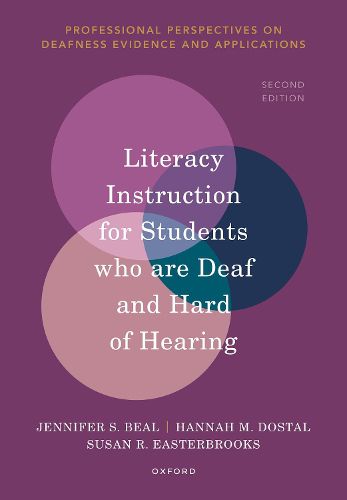Readings Newsletter
Become a Readings Member to make your shopping experience even easier.
Sign in or sign up for free!
You’re not far away from qualifying for FREE standard shipping within Australia
You’ve qualified for FREE standard shipping within Australia
The cart is loading…






Most students who are deaf or hard of hearing (DHH) struggle with acquiring literacy skills, some as a direct result of their hearing loss, some because they are receiving insufficient modifications to access the general education curriculum, and some because they have additional learning challenges necessitating significant program modifications. This second edition of Literacy Instruction for Students who are Deaf and Hard of Hearing updates previous findings and describes current, evidence-based practices in teaching literacy to DHH learners. Beal, Dostal, and Easterbrooks provide educators and parents with a process for determining which literacy and language assessments are appropriate for individual DHH learners and whether an instructional practice is supported by evidence or causal factors. They describe the literacy process with an overview of related learning theories, language and literacy assessments, and evidence-based instructional strategies across the National Reading Panel's five areas of literacy instruction: phonemic awareness, phonics, vocabulary, fluency, and comprehension.The volume includes evidence-based writing strategies and case vignettes that highlight application of assessments and instructional strategies within each of these literacy areas. Crucially, it reviews the remaining challenges related to literacy instruction for DHH learners. Educators and parents who provide literacy instruction to DHH learners will benefit from the breadth and depth of literacy content provided in this concise literacy textbook.
$9.00 standard shipping within Australia
FREE standard shipping within Australia for orders over $100.00
Express & International shipping calculated at checkout
Most students who are deaf or hard of hearing (DHH) struggle with acquiring literacy skills, some as a direct result of their hearing loss, some because they are receiving insufficient modifications to access the general education curriculum, and some because they have additional learning challenges necessitating significant program modifications. This second edition of Literacy Instruction for Students who are Deaf and Hard of Hearing updates previous findings and describes current, evidence-based practices in teaching literacy to DHH learners. Beal, Dostal, and Easterbrooks provide educators and parents with a process for determining which literacy and language assessments are appropriate for individual DHH learners and whether an instructional practice is supported by evidence or causal factors. They describe the literacy process with an overview of related learning theories, language and literacy assessments, and evidence-based instructional strategies across the National Reading Panel's five areas of literacy instruction: phonemic awareness, phonics, vocabulary, fluency, and comprehension.The volume includes evidence-based writing strategies and case vignettes that highlight application of assessments and instructional strategies within each of these literacy areas. Crucially, it reviews the remaining challenges related to literacy instruction for DHH learners. Educators and parents who provide literacy instruction to DHH learners will benefit from the breadth and depth of literacy content provided in this concise literacy textbook.